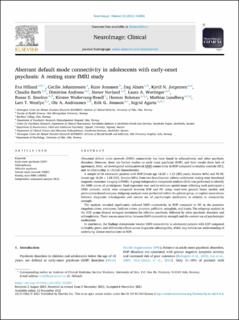| dc.contributor.author | Hilland, Eva | |
| dc.contributor.author | Johannessen, Cecilie Haggag | |
| dc.contributor.author | Jonassen, Rune | |
| dc.contributor.author | Alnæs, Dag | |
| dc.contributor.author | Jørgensen, Kjetil Nordbø | |
| dc.contributor.author | Barth, Claudia | |
| dc.contributor.author | Andreou, Dimitrios | |
| dc.contributor.author | Nerland, Stener | |
| dc.contributor.author | Wortinger, Laura Anne | |
| dc.contributor.author | Smelror, Runar | |
| dc.contributor.author | Wedervang-Resell, Kirsten | |
| dc.contributor.author | Bohman, Hannes | |
| dc.contributor.author | Lundberg, Mathias | |
| dc.contributor.author | Westlye, Lars Tjelta | |
| dc.contributor.author | Andreassen, Ole | |
| dc.contributor.author | Jönsson, Erik Gunnar | |
| dc.contributor.author | Agartz, Ingrid | |
| dc.date.accessioned | 2021-12-16T12:05:39Z | |
| dc.date.available | 2021-12-16T12:05:39Z | |
| dc.date.created | 2021-12-08T13:16:55Z | |
| dc.date.issued | 2021 | |
| dc.identifier.citation | NeuroImage: Clinical. 2021, 33 . | en_US |
| dc.identifier.issn | 2213-1582 | |
| dc.identifier.uri | https://hdl.handle.net/11250/2834710 | |
| dc.description.abstract | Abnormal default mode network (DMN) connectivity has been found in schizophrenia and other psychotic disorders. However, there are limited studies on early onset psychosis (EOP), and their results show lack of agreement. Here, we investigated within-network DMN connectivity in EOP compared to healthy controls (HC), and its relationship to clinical characteristics. A sample of 68 adolescent patients with EOP (mean age 16.53 ± 1.12 [SD] years, females 66%) and 95 HC (mean age 16.24 ± 1.50 [SD], females 60%) from two Scandinavian cohorts underwent resting state functional magnetic resonance imaging (rsfMRI). A group independent component analysis (ICA) was performed to identify the DMN across all participants. Dual regression was used to estimate spatial maps reflecting each participant’s DMN network, which were compared between EOP and HC using voxel-wise general linear models and permutation-based analyses. Subgroup analyses were performed within the patient group, to explore associations between diagnostic subcategories and current use of psychotropic medication in relation to connectivity strength. The analysis revealed significantly reduced DMN connectivity in EOP compared to HC in the posterior cingulate cortex, precuneus, fusiform cortex, putamen, pallidum, amygdala, and insula. The subgroup analysis in the EOP group showed strongest deviations for affective psychosis, followed by other psychotic disorders and schizophrenia. There was no association between DMN connectivity strength and the current use of psychotropic medication. In conclusion, the findings demonstrate weaker DMN connectivity in adolescent patients with EOP compared to healthy peers, and differential effects across diagnostic subcategories, which may inform our understanding of underlying disease mechanisms in EOP | en_US |
| dc.language.iso | eng | en_US |
| dc.publisher | Elsevier | en_US |
| dc.rights | Attribution-NonCommercial-NoDerivatives 4.0 Internasjonal | * |
| dc.rights.uri | http://creativecommons.org/licenses/by-nc-nd/4.0/deed.no | * |
| dc.subject | Schizophrenia | en_US |
| dc.subject | Affective psychosis | en_US |
| dc.subject | Early-onset psychosis | en_US |
| dc.subject | Independent component analysis | en_US |
| dc.title | Aberrant default mode connectivity in adolescents with early-onset psychosis: A resting state fMRI study | en_US |
| dc.type | Peer reviewed | en_US |
| dc.type | Journal article | en_US |
| dc.description.version | publishedVersion | en_US |
| dc.source.articlenumber | 102881 | en_US |
| cristin.ispublished | true | |
| cristin.fulltext | original | |
| cristin.qualitycode | 1 | |
| dc.identifier.doi | https://doi.org/10.1016/j.nicl.2021.102881 | |
| dc.identifier.cristin | 1966220 | |
| dc.source.journal | NeuroImage: Clinical | en_US |
| dc.source.volume | 33 | en_US |
| dc.source.pagenumber | 8 | en_US |

